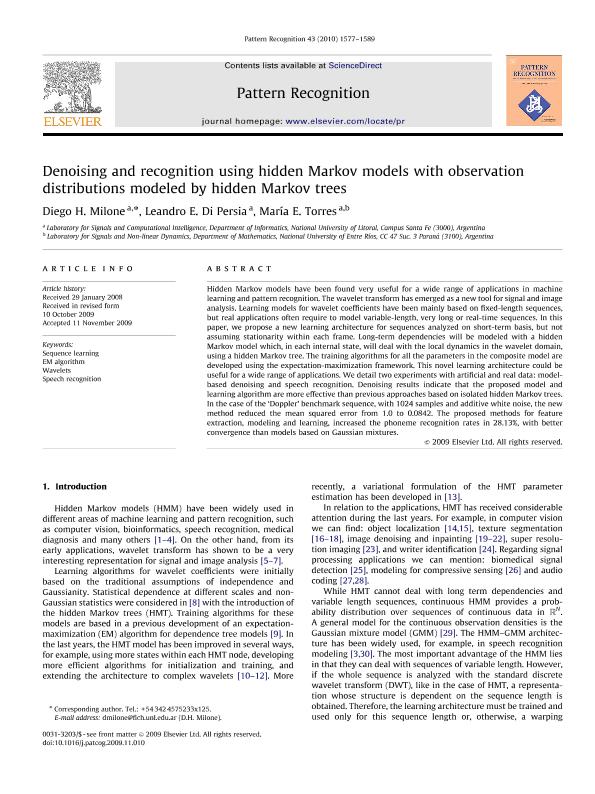Mostrar el registro sencillo del ítem
dc.contributor.author
Milone, Diego Humberto

dc.contributor.author
Di Persia, Leandro Ezequiel

dc.contributor.author
Torres, Maria Eugenia

dc.date.available
2020-02-14T19:40:50Z
dc.date.issued
2010-04
dc.identifier.citation
Milone, Diego Humberto; Di Persia, Leandro Ezequiel; Torres, Maria Eugenia; Denoising and recognition using hidden Markov models with observation distributions modeled by hidden Markov trees; Elsevier; Pattern Recognition; 43; 4; 4-2010; 1577-1589
dc.identifier.issn
0031-3203
dc.identifier.uri
http://hdl.handle.net/11336/97607
dc.description.abstract
Hidden Markov models have been found very useful for a wide range of applications in machine learning and pattern recognition. The wavelet transform has emerged as a new tool for signal and image analysis. Learning models for wavelet coefficients have been mainly based on fixed-length sequences, but real applications often require to model variable-length, very long or real-time sequences. In this paper, we propose a new learning architecture for sequences analyzed on short-term basis, but not assuming stationarity within each frame. Long-term dependencies will be modeled with a hidden Markov model which, in each internal state, will deal with the local dynamics in the wavelet domain, using a hidden Markov tree. The training algorithms for all the parameters in the composite model are developed using the expectation-maximization framework. This novel learning architecture could be useful for a wide range of applications. We detail two experiments with artificial and real data: model-based denoising and speech recognition. Denoising results indicate that the proposed model and learning algorithm are more effective than previous approaches based on isolated hidden Markov trees. In the case of the 'Doppler' benchmark sequence, with 1024 samples and additive white noise, the new method reduced the mean squared error from 1.0 to 0.0842. The proposed methods for feature extraction, modeling and learning, increased the phoneme recognition rates in 28.13%, with better convergence than models based on Gaussian mixtures.
dc.format
application/pdf
dc.language.iso
eng
dc.publisher
Elsevier

dc.rights
info:eu-repo/semantics/openAccess
dc.rights.uri
https://creativecommons.org/licenses/by-nc-sa/2.5/ar/
dc.subject
Sequence learning
dc.subject
EM algorithm
dc.subject
Wavelets
dc.subject
Speech recognition
dc.subject.classification
Ciencias de la Computación

dc.subject.classification
Ciencias de la Computación e Información

dc.subject.classification
CIENCIAS NATURALES Y EXACTAS

dc.title
Denoising and recognition using hidden Markov models with observation distributions modeled by hidden Markov trees
dc.type
info:eu-repo/semantics/article
dc.type
info:ar-repo/semantics/artículo
dc.type
info:eu-repo/semantics/publishedVersion
dc.date.updated
2020-02-13T18:57:31Z
dc.journal.volume
43
dc.journal.number
4
dc.journal.pagination
1577-1589
dc.journal.pais
Países Bajos

dc.journal.ciudad
Amsterdam
dc.description.fil
Fil: Milone, Diego Humberto. Facultad de Ingeniería y Ciencias Hídricas; Argentina
dc.description.fil
Fil: Di Persia, Leandro Ezequiel. Universidad Nacional del Litoral. Facultad de Ingeniería y Ciencias Hídricas. Departamento de Informática. Laboratorio de Investigaciones en Señales e Inteligencia Computacional; Argentina
dc.description.fil
Fil: Torres, Maria Eugenia. Universidad Nacional de Entre Rios. Facultad de Ingeniería. Departamento de Matemática E Informatica; Argentina
dc.journal.title
Pattern Recognition

dc.relation.alternativeid
info:eu-repo/semantics/altIdentifier/doi/http://dx.doi.org/10.1016/j.patcog.2009.11.010
Archivos asociados
